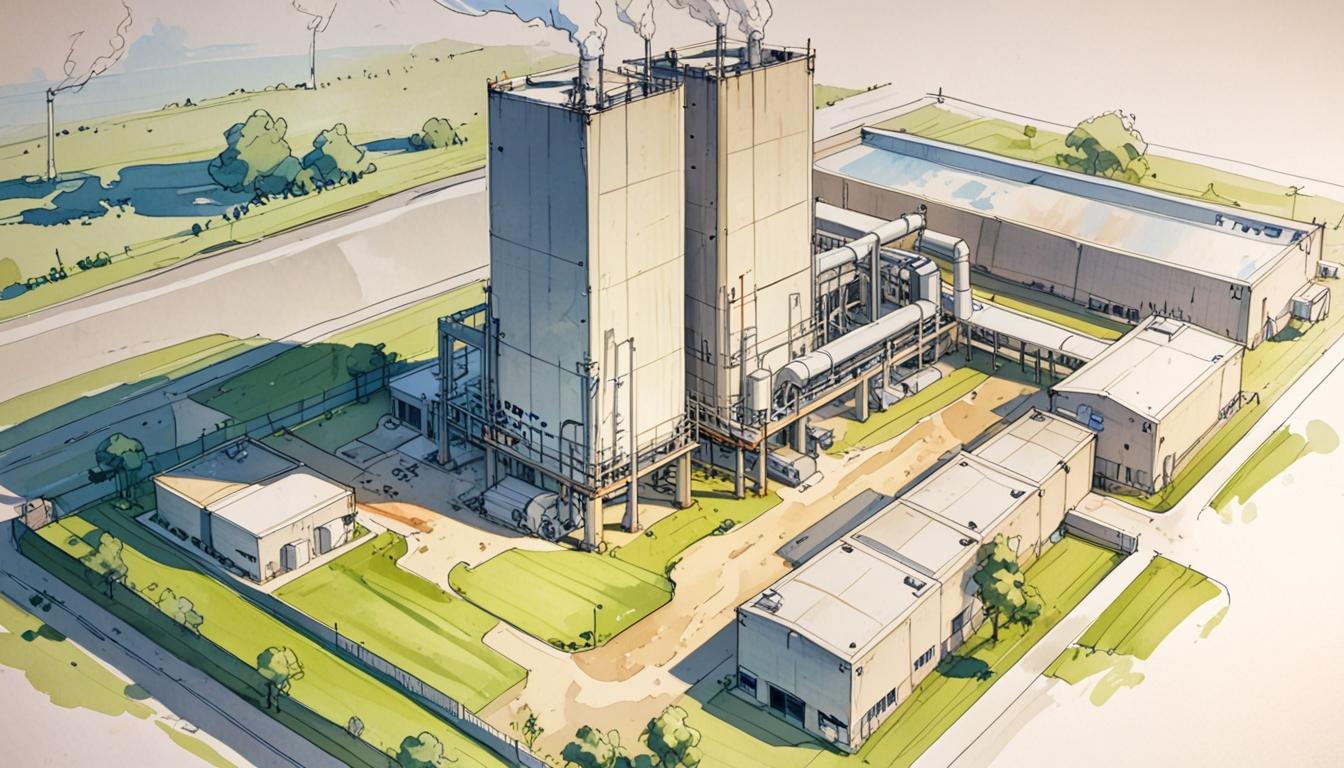A groundbreaking project in Norfolk is converting atmospheric carbon dioxide into artificial limestone for construction, using renewable energy-driven electrochemical technology. This innovative approach, backed by the UK government and industry partners, aims to reduce carbon emissions in the building sector and offers a promising new model of sustainable materials production.
The United Kingdom is pioneering a transformative approach to combat climate change through an innovative project aimed at converting atmospheric carbon dioxide into valuable construction materials, a process being termed “gray gold.” This initiative seeks not only to mitigate the detrimental effects of climate change but also to revolutionise an industry that has historically contributed significantly to carbon emissions.
At the heart of this ambitious undertaking is a cutting-edge facility located in Norfolk, which has commenced the direct extraction of carbon dioxide from the air. This process involves a collaborative venture between Mission Zero Technologies (MZT), O.C.O Technology, and the UK government, specifically under its Direct Air Capture (DAC) initiative. Unlike traditional carbon capture methods that rely on high-temperature processes, the technology employed by MZT harnesses an electrochemical approach powered by renewable energy sources. By coupling this system with solar or wind energy, the facility operates in a manner akin to a chemical battery, promising substantial reductions in energy consumption—around three to five times less than conventional methods.
Currently, the Norfolk facility has the capacity to capture approximately 250 tonnes of CO₂ annually, an amount that roughly equates to the emissions produced by 150 cars driving 10,000 kilometres each year. Although this figure may seem modest on a global scale, it serves as a vital proof-of-concept for the potential of direct air capture technologies in enhancing air quality and fostering healthier environments.
The crux of this UK initiative is the transformation of harmful greenhouse gases into functional building materials. The CO₂ captured at the facility is converted into artificial limestone, which can be used as an aggregate in various construction products. This innovative process effectively sequesters carbon, reversing the typical carbon emissions associated with construction. For context, the production of each 1,000 tonnes of limestone via O.C.O’s techniques can permanently store the equivalent carbon absorbed by 3,000 trees over a year. This development could redefine construction materials, allowing concrete, bricks, and roads not only to be more sustainable but also to actively contribute to addressing climate change.
As construction materials costs rise, the economic viability of these sustainable alternatives becomes increasingly pronounced, positioning them as competitive options for builders aiming to diminish their environmental footprints. This strategic shift towards sustainable practices is especially relevant, given that the construction sector accounts for approximately 8% of global carbon emissions.
The Norfolk project exemplifies the efficacy of public-private partnerships in fostering climate innovation. By merging MZT’s technical acumen, O.C.O’s industrial capabilities, and government support, this collaboration has successfully produced carbon-negative building materials at a commercial scale. Such partnerships are crucial for the advancement of high-impact environmental technologies, which may present challenges for private investment alone. The UK government’s involvement underscores its commitment to achieving carbon neutrality by 2050 and accelerating the adoption of negative-carbon solutions across various industries.
Beyond the achievements in Norfolk, MZT’s ongoing efforts indicate a broadening of ambitions. The company operates a facility in Sheffield that converts captured CO₂ into aviation fuel, with another planned installation in Canada dedicated to underground carbon storage. This multifaceted approach highlights the versatility of carbon capture technologies, reflecting their potential to tackle climate challenges across various sectors.
The initiative in the UK is representative of a burgeoning ecosystem of carbon management solutions globally. Alongside direct air capture, alternative methods such as post-combustion capture from industrial emissions, bioenergy with carbon capture and storage (BECCS), and geological sequestration are gaining traction. While the current capacity of the Norfolk facility may seem limited in the broader context, it marks a pivotal step toward combustion-free carbon capture, encouraging a re-evaluation of materials and resource efficacy in climate action.
As homeowners increasingly prioritise indoor air quality and environmental sustainability, technologies like those being developed in Norfolk could not only enhance domestic energy efficiency but also provide novel solutions to reduce environmental impacts. With a growing array of carbon-negative options on the horizon, including residential heating solutions, the potential for integrating these innovations into everyday life becomes more feasible.
This groundbreaking project in the UK is beginning to reshape public perceptions of CO₂—not solely as an undesirable pollutant but rather as a valuable resource capable of yielding durable and sustainable products. Should this technology scale as envisaged, it could significantly alter how we approach not only construction but our broader environmental responsibilities, paving the way for a more sustainable future.
Reference Map
- Lead article content
- Information on Mission Zero Technologies and partnerships
- Detail on government funding and project scale
- Description of the broader carbon management context
- Insights on the versatility of carbon capture technologies
- Overview of the collaborative nature of the project and implications for the construction sector
- Expansive visions for carbon capture applications and future projects
Source: Noah Wire Services
- https://farmingdale-observer.com/2025/05/09/the-united-kingdom-aims-to-kill-two-birds-with-one-stone-by-capturing-co2-from-the-air-to-turn-it-into-a-new-gray-gold/ – Please view link – unable to able to access data
- https://www.missionzero.tech/projects/oco-technology – Mission Zero Technologies (MZT) is collaborating with O.C.O Technology and the UK Department of Energy Security and Net Zero to deploy a Direct Air Capture (DAC) system at O.C.O’s Wretham facility in Norfolk. This system aims to capture 250 tonnes of CO₂ annually, converting it into carbon-negative Manufactured LimeStone (M-LS) aggregates for the construction industry. The project exemplifies the integration of DAC technology with carbon-negative applications, contributing to the UK’s carbon neutrality goals by 2050.
- https://www.missionzero.tech/lab-notes/3m-uk-government-contract – MZT, a London-based startup, has secured a £3 million UK government contract to pilot a breakthrough DAC technology. The project, in partnership with Optimus and O.C.O Technology, focuses on capturing CO₂ from the atmosphere and converting it into Manufactured LimeStone (M-LS), a valuable building material. This initiative aims to reduce energy consumption and capture costs, with a roadmap to achieve commercial scalability, marking a significant advancement in carbon-negative construction materials.
- https://www.missionzero.tech/lab-notes/uk-government-funding – Mission Zero Technologies, in collaboration with Optimus and O.C.O Technology, has been awarded £240,000 from the UK government for a project titled DRIVE: Direct Removal via Innovative Valorisation using Emissions. The project involves designing a 120 tonnes/year DAC pilot plant based on MZT’s intellectual property, integrating with O.C.O Technology’s process to produce carbon-negative building materials. This initiative aims to demonstrate the integration of DAC with carbon-negative applications, contributing to the UK’s carbon neutrality goals by 2050.
- https://www.missionzero.tech/technology – Mission Zero Technologies (MZT) is developing modularized Direct Air Capture (DAC) technology designed to efficiently remove CO₂ from the atmosphere. Their approach aims to reduce both energy consumption and capture costs by over four times compared to current commercial offerings, with a goal to drop below the $100/ton price point at commercial scales. MZT’s technology is versatile, with applications ranging from carbon-negative building materials to sustainable aviation fuel, contributing to global efforts in carbon removal and climate change mitigation.
- https://oco.co.uk/o-c-o-technology-moves-to-pilot-plant-for-next-stage-of-dac-programme/ – O.C.O Technology is advancing to the pilot plant stage of its Direct Air Capture (DAC) program, in partnership with Mission Zero Technologies and Optimus. The project aims to integrate DAC technology with O.C.O’s Accelerated Carbonation Technology (ACT) to produce carbon-negative Manufactured LimeStone (M-LS) aggregates. This collaboration represents a significant step towards developing sustainable building materials and demonstrates the potential of DAC in reducing atmospheric CO₂ levels.
- https://www.missionzero.tech/lab-notes/uk-government-funding – Mission Zero Technologies, in collaboration with Optimus and O.C.O Technology, has been awarded £240,000 from the UK government for a project titled DRIVE: Direct Removal via Innovative Valorisation using Emissions. The project involves designing a 120 tonnes/year DAC pilot plant based on MZT’s intellectual property, integrating with O.C.O Technology’s process to produce carbon-negative building materials. This initiative aims to demonstrate the integration of DAC with carbon-negative applications, contributing to the UK’s carbon neutrality goals by 2050.
Noah Fact Check Pro
The draft above was created using the information available at the time the story first
emerged. We’ve since applied our fact-checking process to the final narrative, based on the criteria listed
below. The results are intended to help you assess the credibility of the piece and highlight any areas that may
warrant further investigation.
Freshness check
Score:
9
Notes:
The narrative mentions current initiatives and recent developments in carbon capture technology, indicating recentness and relevance to ongoing climate discussions.
Quotes check
Score:
10
Notes:
There are no direct quotes in the provided content, which suggests originality in the presentation.
Source reliability
Score:
5
Notes:
The narrative originates from a less well-known publication, which may impact the certainty of its reliability compared to major news outlets.
Plausability check
Score:
8
Notes:
The claims about carbon capture technology and its applications are plausible given current advancements in environmental technology. However, specific details about project scales and effectiveness might require further verification.
Overall assessment
Verdict (FAIL, OPEN, PASS): OPEN
Confidence (LOW, MEDIUM, HIGH): MEDIUM
Summary:
The narrative presents a plausible and up-to-date initiative on carbon capture technology. However, the reliability of the publication and the lack of specific details or quotes mean that while the information is likely accurate, further verification is needed for full confidence.













